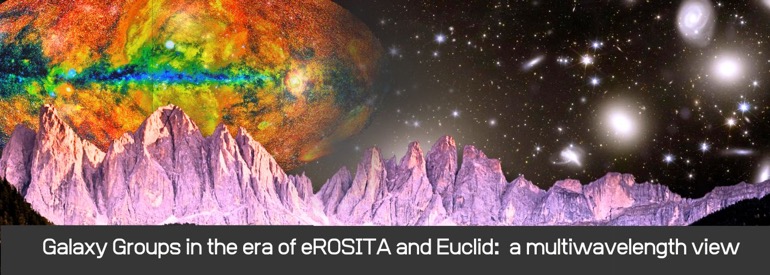
Galaxy Groups in the era of eROSITA and Euclid: a multiwavelength view
LOCATION: Haus Sexten - Via Dolomiti 45, 39030, Sexten
DETAILS
Deadline for title/abstract: February 16th, 2024
Galaxy groups consist of a few tens of galaxies bound in a common gravitational potential, dominate the number count of the halo mass function, and contain a significant fraction of the overall universal baryon budget. Therefore, they are key to our understanding of how the bulk of matter in the Universe accretes and forms hierarchical structures and how different sources of feedback affect their gravitational collapse. However, despite their crucial role in cosmic structure formation and evolution, galaxy groups have received less attention compared to massive clusters.
This is in part due to their rarity in being observed and properly characterized. With the advent of eROSITA (launched in 2019), many thousands of galaxy groups will be detected by X-ray, complementing ongoing and future X-ray (XMM-Newton, Chandra, XRISM, Athena) optical (Euclid, DES, Vera Rubin, J-PAS, DESI, 4MOST/ESO), SZ (SPT-3G, SPT-4G, ACT), and radio (LOFAR, MeerKAT) surveys.
The aim of this conference is to bring together theoreticians and observational astronomers working at different wavelengths to discuss the latest developments in our understanding of these systems and present future prospects in the study of the physical properties of galaxy groups.
During the conference we plan to:
– review and discuss the galaxy group properties with multi-wavelength data:
- probe the composition of the galaxy populations in optical and IR bands;
- revise the properties of the warm, hot intra-group medium gas with detailed X-ray, SZ, and radio observations;
- probe the incidence of AGN feedback in nearby galaxy groups with multi wavelengths data;
- investigate the nature of fossil galaxy groups and their role in the hierarchical structure formation.
– review and discuss the current theoretical picture of groups formation and evolution:
- by comparing the details of the AGN feedback from hydrodynamic simulations with observations
- by discussing the current limitations and the perspectives for improving the theoretical modeling in the near future.
INVITED SPEAKERS
Bahar E.
Brienza M.
Bruggen M.
De Lucia G.
Dolag K.
Driver S.
Eckert D.
Gaspari M.
Hatch N.
Mernier F.
Oppenheimer B.
Pillepich A.
Popesso P.
Sun M.
Zarattini S.
RELATED FILES
FEE
Senior: 350E PhD/students: 300E
WORKSHOP CODE FOR PAYMENT
GGR24
ORGANIZERS
SOC
Lovisari L., Eckert D., Ettori S., Gastaldello F., Biffi V., Bonafede A., Donahue M., Finoguenov A., Mcgee S., Nelson D., Vulcani B.
